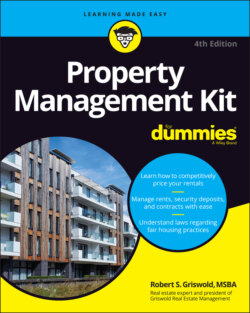Читать книгу Property Management Kit For Dummies - Robert S. Griswold - Страница 3
Property Management Kit For Dummies® To view this book's Cheat Sheet, simply go to www.dummies.com and search for “Property Management Kit For Dummies 4th Edition Cheat Sheet” in the Search box. Table of Contents
Оглавление1 Cover
2 Title Page
3 Copyright
4 Introduction About This Book Foolish Assumptions Icons Used in This Book Beyond the Book Where to Go from Here
5 Part 1: So You Want to Be a Landlord? Chapter 1: Residential Property Management 101 Understanding Property Management Examining Types of Real Estate Renting Your Property Getting Your Hands Dirty: Managing the Property Chapter 2: Do You Have What It Takes to Manage Your Own Rental Property? Understanding That Managing Residential Rental Property Is a People Business Identifying the Types of Real Estate Owners Recognizing the Advantages of Owning Rental Property Eyeing the Unique Characteristics of a Good Manager Being Honest with Yourself about Your Skills and Experience Chapter 3: Managing Your Residential Property Yourself or Hiring a Pro Managing Your Rental Yourself Exploring Professional Management Chapter 4: Taking Over the Property Knowing What to Get Up Front Working with the Current Tenants During the Transition
6 Part 2: Renting Your Property Chapter 5: Getting Your Residential Rental Property Ready for Prospective Tenants Viewing Your Rental Property from a Prospective Tenant’s Shoes Preparing Your Rental Unit the Right Way Using Outside Contractors Chapter 6: The Big Three of Property Management: Rent, Security Deposits, and Rental Contracts Setting the Rent Coming Up with a Fair Security Deposit Choosing the Type of Rental Contract You Want Chapter 7: Formulating a Marketing Plan Developing a Successful Marketing Plan Understanding the Importance of Good Advertising Being Aware of Fair-Housing Laws Chapter 8: FOR RENT: Effectively Using Advertising to Generate Interest Analyzing Your Advertising Options Chapter 9: Handling Prospects When They Come A-Calling Understanding Why First Impressions Are Important Valuing Phone Conversations Preparing for Rental Inquiry Phone Calls Planning for Open Houses and Walk-Throughs Chapter 10: Strutting Your Stuff: Making Your Property Memorable Showing Your Rental Unit Taking the First Steps to Get the Renter Interested Handling Mandatory Disclosures and Environmental Issues Chapter 11: Eenie, Meenie, Miney, Mo: Selecting Your Tenants Understanding the Importance of Screening Establishing Tenant Selection Criteria Verifying Rental Applications Notifying the Applicant of Your Decision Avoiding Housing Discrimination Complaints
7 Part 3: The Brass Tacks of Managing Rentals Chapter 12: Moving In the Tenants Establishing the Move-In Date Meeting with a Tenant Before Move-In Setting Up the Tenant File Preparing a Welcome Package for Your New Tenant Chapter 13: Collecting and Increasing Rent Creating a Written Rent Collection Policy Dealing with Rent Collection Problems Raising the Rent without Sending Your Tenants Running Chapter 14: Keeping the Good Tenants (And Your Sanity) Knowing What Tenants Want Recognizing the Ins and Outs of Renewing Leases Chapter 15: Dealing with Problem Tenants Recognizing and Responding to Common Tenant Problems Exploring Alternatives to Eviction Giving ’Em the Boot: Evicting a Tenant Handling Unusual Tenant Situations Chapter 16: Moving Out the Tenants Requiring Written Notice of Your Tenants’ Move-Out Plans Providing Your Tenant a Move-Out Information Letter Walking Through the Unit at Move-Out Dealing with Special Situations
8 Part 4: Techniques and Tools for Managing Your Residential Property Chapter 17: Working with Employees and Contractors Surveying the Ins and Outs of Bringing Employees Onboard Building Your Contractor and Vendor Dream Team Chapter 18: Maintaining the Property Recognizing the Importance of a Maintenance Plan Being Prepared for Maintenance Issues Handling Rental Property Maintenance Chapter 19: Keeping Safety and Crime Prevention in Mind Tackling Crime in and around Your Rental Property Taking Necessary Crime-Deterrent Precautions Prioritizing Tenant Safety Addressing Environmental Issues
9 Part 5: Money, Money, Money! Chapter 20: Two Necessities of Property Management: Insurance and Taxes Developing a Risk-Management Plan Cover Me, I’m Going In: Making Sure You Have the Insurance You Need Talking with Tenants about Renter’s Insurance Understanding the Tax Angles Chapter 21: Financial Management and Record-Keeping Organizing Your Files Maintaining Property Records Taking Care of Business: Accounting Chapter 22: Finding New Ways to Increase Your Cash Flow Considering Nonrent Revenue Putting Lease Options to Work for You Taking Advantage of Government Programs Working in Niche Markets
10 Part 6: The Part of Tens Chapter 23: Ten Reasons to Become a Residential Rental Property Owner You Can Diversify Your Investments You Don’t Need Much Money to Start It Can Be a Second Income You Gain Tax Advantages Real Estate Holds Its Value You Get Leverage It Beats Inflation You Can Shelter Your Income You Get a Positive Cash Flow It Can Help You Retire Chapter 24: Ten Ways to Rent Your Vacant Rental Unit Maintain Curb Appeal Keep the Unit in Rent-Ready Condition Establish a Competitive Rent Offer Prospects a Rate Guarantee Provide Wireless Internet Access Offer Referral Fees Accept Pets Offer Move-In Gifts or Upgrades Contact Corporate Relocation Services Accept HUD’s Housing Choice Vouchers
11 Appendix: About the Online Kit Materials
12 Index
13 About the Author
14 Advertisement Page
15 Connect with Dummies
16 End User License Agreement
